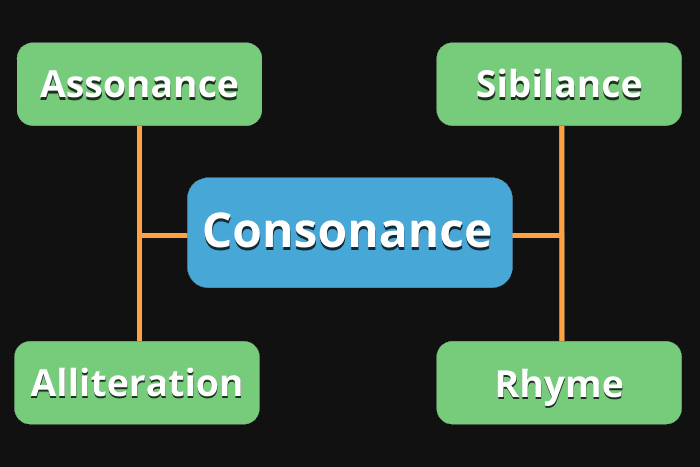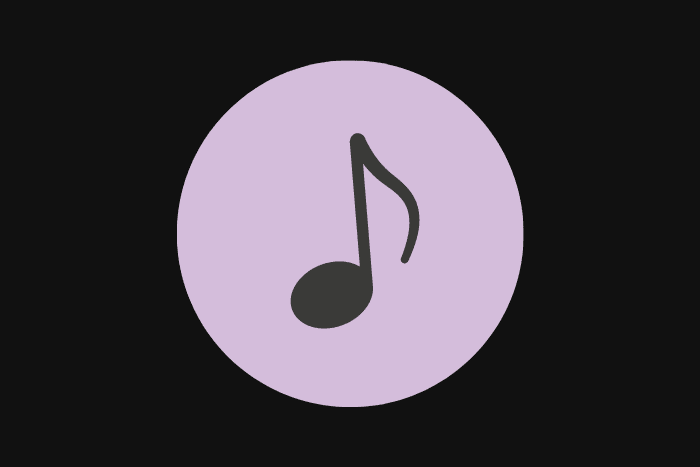What can a selection of well-crafted consonance examples do to make your writing more memorable?
That’s the goal, right?
To have your words to live rent-free in your readers’ heads and have lasting resonance?
As you’ll see from the numerous examples provided below, consonance shows up in popular poems, songs, and also in our favorite films.
It makes lines of great literature linger in our collective memory. And it captures our attention with clever names for businesses, products, and fictional characters.
Ready to learn how to make your writing stand out and stick in your reader’s minds?
Then read on!
What is Consonance?
Consonance is a stylistic literary device that repeats the same consonant sound within a group of words.
For example, Paddy’s potatoes were prepared to perfection, is an example of consonance.
(It’s also an alliteration example, but more on that in a second).
Now, this repetition of consonant sounds doesn’t always use the same letters.
Also, the repetition can happen anywhere in the word — beginning, middle, or end — and in a stressed or unstressed syllable.
Now that you have a consonance definition, let’s learn how it can make your writing resonate with readers.
But before we do that, let’s take a look at some terms related to consonance.
Related Terms

While consonance can stand alone, it often overlaps with the following literary devices:
- Assonance — repetition of vowel sounds
- Sibilance — repetition of /s/, /sh/, and /z/ sounds
- Alliteration — the repetition of sounds (vowel or consonant) at the beginning of a series of words
- Rhyme — the repetition of sounds located at the ends of words
Consonance vs. Alliteration
Alliteration occurs when either vowel or consonant sounds repeat at the start of a word.
Consonance, however, repeats only consonant sounds (and can repeat those sounds anywhere in a word).
The examples below are both consonance and alliteration:
- “They paved paradise and put up a parking lot.”
- Counting Crows
- Beastie Boys
- Foo Fighters
- Lucy Liu
- Jesse Jackson
- Mickey Mantle
Now, look at this sentence:
“Jeffery and Tiffany have tough phones”.
Notice how the repeated consonant sounds appear at different positions in the words and not just at the beginning?
And it’s because of those varying positions, this sentence is an example of consonance but not alliteration.
Consonance vs. Sibilance
While the broader term consonance can include all consonant sounds, sibilance is a type of consonance limited to /s/, /sh/, and /z/ sounds – mostly the first two, which create a hissing or whooshing sound.
Examples:
- Words like sassafras, circumstance, residency
- Terms like “blessing in disguise,” “last but not least,” “X marks the spot”
- Poetic verses like “And the silken sad uncertain rustling of each purple curtain.”
Consonance vs. Rhyme
Rhyme is a kind of consonance that typically happens at the ends of words.
While rhyme always involves the repetition of sounds — usually a vowel-consonant combination — neither consonance nor assonance have to rhyme.
Examples:
- Expressions like “See you later, alligator” and “too cool for school”
- Rhyming poetry: “I do not like green eggs and ham. I do not like them Sam-I-Am.”
- Nursery rhymes like “Jack and Jill went up the hill…” and “Hickory dickory dock / the mouse ran up the clock.”
25 More Examples of Consonance
Now that you have a better idea of what consonance is, the following 25 examples show just how often we use it, formally and informally.
Examples of Consonance in Everyday Speech

The most common examples of consonance in everyday speech happen with expressions that have become part of our vocabulary:
- Fuddy duddy
- Pitter patter
- Lily livered
- Twist tie
- Taco Tuesdays
Examples of Consonance in “Tongue Twisters”

Tongue twisters offer another popular example of consonance.
Some of the following are used to help children and non-native speakers improve their articulation of English:
“If Peter Piper picked a peck of pickled peppers
Where’s the peck of pickled peppers Peter Piper picked?”
And:
“She sells seashells on the seashore.
The shells she sells are seashells, I’m sure.
And if she sells seashells on the seashore,
Then I’m sure she sells seashore shells.”
Also:
“Betty Botter bought some butter
But she said the butter’s bitter
If I put it in my batter, it will make my batter bitter
But a bit of better butter will make my batter better
So ‘twas better Betty Botter bought a bit of better butter.”
And this one:
“How much wood would a woodchuck chuck if a woodchuck could chuck wood?
He would chuck, he would, as much as he could, and chuck as much wood
As a woodchuck would if a woodchuck could chuck wood.”
Examples of Consonance in Literature

Literature provides plenty of examples of consonance — alliterative and otherwise.
Here are just a few examples:
Hamlet by William Shakespeare:
“A little more than kin, and less than kind.”
Moby Dick by Herman Melville:
“Nearly all joined in singing this hymn, which swelled high about the howling of the storm …”
Beowulf:
“Heorot trembled, wonderfully built to withstand the blows, the struggling great bodies beating at its beautiful walls…”
Macbeth by William Shakespeare:
“Shipwracking storms and direful thunders break,
So from that spring whence comfort seemed to come
Discomfort swells. Mark, King of Scotland, mark”
Consonance Examples in Music

Rhyme is one-way consonance shows up in music lyrics, but it’s not the only one, as you’ll see in the following examples:
“The Biggest Thing that Man Had Ever Done” by Woody Guthrie:
“I beat the daring Roman, I beat the daring Turk
Defeated Nero’s army with thirty minutes’ work,
I fought the greatest leaders and licked them everyone,
And that was about the biggest thing that man had ever done …”
“Subterranean Homesick Blues” by Bob Dylan:
“Maggie comes fleet foot
Face full-a black soot
Talkin’ that the heat put
Plants in the bed but …”
“Sssh” by Apex Theory:
“While customers consume large quantities
Of curiously cultivated curtains
Alongside crowds of crude oils
Crossed and crooked”
“Zealots” by Fugees:
“Rap rejects, my tape deck, ejects projectiles
Whether Jew or Gentile, I rank top percentile
Many styles, more powerful than gamma rays
My grammar pays like Carlos Santana plays…”
Examples of Consonance in Poetry

Poets use consonance in a variety of ways to keep their readers’ eyes moving from line to line — even without rhyme — and keep those words circulating in their memory.
Enjoy the following examples:
“The Acrobats” by Shel Silverstein:
“I’ll swing by my ankles.
She’ll cling to your knees.
As you hang by your nose,
From a high-up trapeze.
But just one thing, please,
As we float through the breeze,
Don’t sneeze.”
“The Raven” by Edgar Allan Poe:
“But the Raven still beguiling all my fancy into smiling,
Straight I wheeled a cushioned seat in front of bird, and bust and door;
Then, upon the velvet sinking, I betook myself to linking
Fancy unto fancy, thinking what this ominous bird of yore—
What this grim, ungainly, ghastly, gaunt, and ominous bird of yore
Meant in croaking “Nevermore.”
“Twas Later When the Summer Came” by Emily Dickenson:
‘Twas later when the summer went
Than when the cricket came,
And yet we knew that gentle clock
Meant nought but going home.
‘Twas sooner when the cricket went
Than when the winter came,
Yet that pathetic pendulum
Keeps esoteric time.”
“Stopping by Woods on a Snowy Evening” by Robert Frost:
“He gives his harness bells a shake
To ask if there is some mistake.
The only other sound’s the sweep
Of easy wind and downy flake.”
“The Miscarriage” by Amit Majmudar:
“Some species can crack pavement with their shoots
to get their share of sun some species lay
a purple froth of eggs and leave it there
to sprinkle tidepools with tadpole confetti
some species though you stomp them in the carpet
have already stashed away the families
that will inherit every floor at midnight.”
Other Famous Examples of Consonance

The following examples don’t fall into the above categories, and some will sound more familiar than others.
In each case, the use of consonance served a purpose — whether to capture the reader’s (or viewer’s) attention or to make a name more memorable.
V for Vendetta (graphic novel and 2005 movie):
“However, this valorous visitation of a bygone vexation stands vivified and has vowed to vanquish these venal and virulent vermin vanguarding vice and vouchsafing the violently vicious and voracious violation of volition!”
Alliterative consonance in brand/store names:
- Coca Cola
- Dunkin’ Donuts
- Best Buy
- Blouse Barn
- Krispy Kreme
- Lifelock
- PayPal
- Constant Contact
- Gorilla Glue
- Merry Maids
Consonance in fictional character names:
- Bilbo Baggins
- Severus Snape
- Rudolph the Red-Nosed Reindeer
- Foghorn Leghorn
- Donald Duck
- Yosemite Sam
- Holly Golightly
- Dread Pirate Roberts
- Fred Flinstone
- Wizard of Oz
Why Use Consonance in Your Writing?
Consonance has a way of standing out, whether it’s used alone or with other literary devices.
So, what makes it so memorable?
- It increases the musicality of words, helping with rhythm and flow.
- It encourages repeated readings (reading aloud is particularly helpful).
- It encourages readers to slow down and pay closer attention, thereby strengthening reader comprehension.
- It can have a special resonance with the meaning of the words used.
- Its sounds can connect to other ideas and inspire new tangents.
Which Consonance Examples Stood Out for You?
Now that you’ve looked through all 25 examples of consonance, it’s time to try your hand at writing some of your own.
Start by taking one of the examples in this post and adding to it. Or write a free verse poem about whatever’s on your mind.
See if you can switch from one consonant sound to another as you write. Rhyme and alliteration are both optional (but encouraged).
When you’re ready, share some of your work online — maybe by writing a very short story (#VSS) on Twitter, using the day’s keyword.
Get some feedback.
Then keep writing.
The post 25+ Carefully Curated & Totally Ample Consonance Examples appeared first on Smart Blogger.


No comments:
Post a Comment